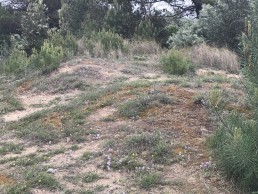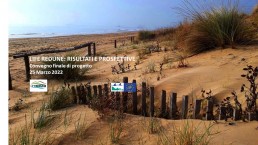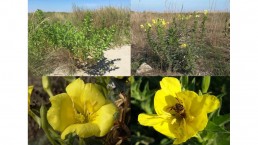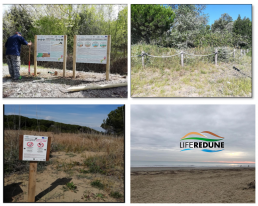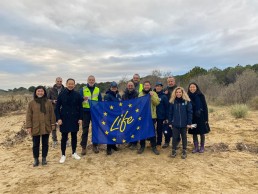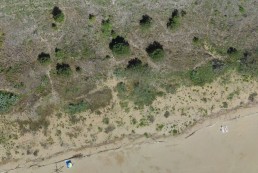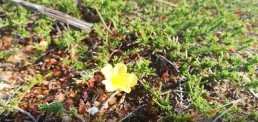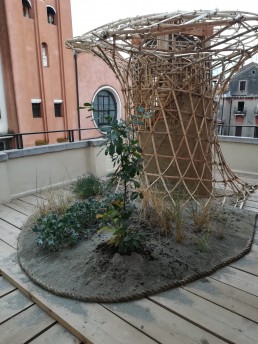LIFE REDUNE GUIDELINES AND MANUALS FOR THE CONSERVATION OF THE HABITATS OF SANDY COASTAL SYSTEMS ARE PUBLISHED
LIFE REDUNE - Restoration of dune habitats in Natura 2000 sites of the Veneto coast (LIFE16 NAT/IT/000589)
The sand dunes are an important reservoir of biodiversity and crucial elements of resilience for the coastline, contributing to the control of coastal erosion and the mitigation of extreme climatic events. They are classified as globally threatened habitats, above all due to very strong anthropogenic pressure linked to the tourism industry.
In this context, the LIFE REDUNE project - "Restoration of dune habitats in Natura 2000 sites of the Veneto coast", co-financed by the European Commission under the LIFE 2014-2020 program, acted.
In the last four years LIFE REDUNE has developed a series of stakeholder engagement strategies and concrete actions for the restoration and conservation of habitats typical of coastal systems along the Veneto coast. From these experiences, and with the literature data and with the knowledge acquired also in collaboration with other projects on similar topics, a manual and four guidelines have been developed, providing good practices for the correct management and long-term conservation of these ecosystems.
1. Propagation manual of Adriatic dune habitat species.
2. Guidelines for sustainable tourism use and correct management for conservation
long-term development of dune ecosystems.
3. Guidelines for the use of drones in monitoring beaches.
4. Guidelines on the involvement of tour operators in the protection of dune habitats.
5. Guidelines for the eradication of Oenothera stucchii.
These documents are available at this link
LIFE REDUNE was coordinated by the Department of Environmental Sciences, Informatics and Statistics of the Ca 'Foscari University of Venice, managed by EPC- European Project Consulting srl with the partnership of the Veneto Region, Veneto Agriculture and SELC soc. coop. The project has redeveloped the habitats 2110, 2120, 2130 * 2250 * and 2270 *, typical of the dune systems of the upper Adriatic, in the areas of Bosco Nordio, Peninsula of Cavallino, Laguna del Mort and Pinete di Eraclea and Laguna di Caorle and Mouth of the Tagliamento.
DUNES AND TOURISM: GUIDELINES FOR SUSTAINABLE MANAGEMENT
The dunes have the important function of naturally defending the hinterland from storm surges. But how to keep the dune systems intact on the beaches invaded by tourists? Experts and scholars who have worked in the field along the Venetian coast in the last four years have developed guidelines for sustainable tourist use and the correct management and long-term conservation of dune ecosystems.
They will be presented during the final event of the LIFE REDUNE project, scheduled for Friday 25 March from 9.30 in the Mainardi Auditorium of the Scientific Campus of the Ca 'Foscari University of Venice (via Torino, 155). The event is open to the public and will be an opportunity to learn about and deepen the ecological value, in terms of biodiversity and ecosystem services, of Mediterranean coastal systems. The conference will be held simultaneously in person and online.
The LIFE REDUNE project "Restoration of dune habitats in Natura 2000 sites of the Veneto coast", co-financed by the European Union and led by researchers from the Department of Environmental Sciences, Informatics and Statistics of the Ca 'Foscari University of Venice, with the partnership of the Veneto Region, Veneto Agriculture, EPC srl and SELC soc. coop., has been active in the restoration and conservation of the habitats typical of coastal systems in the areas of Bosco Nordio, Peninsula of Cavallino, Laguna del Mort and Pinete di Eraclea and Laguna di Caorle and Foce del Tagliamento.
The conference aims to promote the exchange of knowledge and good practices for the conservation and sustainable management of sandy coastal systems. Classified as globally threatened habitats, these ecosystems are an important reservoir of biodiversity and crucial elements of resilience of coastal territories, contributing to the control of coastal erosion and the mitigation of extreme climatic events
Attendants:
Gabriella Buffa , Ca 'Foscari University of Venice - Scientific Coordinator of LIFE REDUNE
Salvatore Orlando , Director of the Department of Environmental Sciences, Computer Science and Statistics of the Ca 'Foscari University of Venice
Cristiano Corazzari , Councilor for Territory, Culture, Security, Migration flows, Hunting and fishing, Veneto Region
Federico Vianello , Director of the Operational Unit for Plumbing, Forestry and Naturalistic Areas, Veneto Agriculture
Speakers:
Annelore Bezzi and Giorgio Fontolan , University of Trieste, The beach and dune system: processes and functions
Alberto Barausse , University of Padua, The conservation of coastal biodiversity in a context of climate change: cost or opportunity for sustainable development? The experience of the Interreg Italy-Slovenia "ECO SMART" project
Alessandro Berton , President of Unionmare Confturismo Veneto, Environmental sustainability as an economic driver for seaside tourism
Giovanni Mattias , Councilor for the Environment Municipality of Pomezia, Managing a man-made dune: the example of the municipality of Pomezia
Marco Abordi , Technical-scientific coordinator of the process "Wet Area Contract of the Caorle and Bibione Lagoon System", The experience of the "Wet Area Contract of the System of the Lagoon of Caorle and Bibione ”in the involvement of all local actors aimed at shared actions for the protection and enhancement of coastal and lagoon ecosystem values.
Corrado Battisti , Metropolitan City of Rome, Citizen Management aimed at protecting disturbed dune ecosystems: case study at 'Torre Flavia' SPA
Giosuè Cuccurullo , Councilor of the Municipality of San Michele al Tagliamento - President of the Foce del Tagliamento Nature Reserve Committee, Here everything is dune
Francesco Cancellieri, Vincenzo Piccione , Assocea Messina APS; President of the Committee of Promoters of the Charter of the Guardian Municipalities of the Mediterranean Macchia, The path of the Charter of the Guardian Municipalities of the Mediterranean Macchia and future perspectives
Federica Piccolo , EPC srl - Communication and Project Manager of LIFE REDUNE, Inform and listen to stakeholders
Edy Fantinato , Ca 'Foscari University of Venice, The containment of tourist flows and anthropogenic pressure
Jacopo Richard , Veneto Agriculture, Methods of cleaning the beach and management of beached material
Francesco Scarton and Marco Baldin , SELC coop. Low-impact naturalistic engineering
Roberto Fiorentin , Veneto Agriculture, Restoring dune habitats
Mauro Giovanni Viti, Veneto Region, Regional adoption of the Guidelines for the sustainable management of beaches
Handcrafting, suitable tools
The yellow-flowered Oenothera stucchii Soldano is an alien species that has colonized the dune systems to the detriment of the native species. The particular germination niche with high affinity for light, high seed production and rapid growth guarantee greater competitiveness in disturbed contexts and a strong tendency to invasiveness. In the areas of intervention of Life Redune, the habitat of choice of O. stucchii is represented by 2130 *.
The Life Redune project involved annual eradication of O. stucchii for three years and monitoring of the populations of O. stucchii to evaluate the effectiveness of the containment action in reducing their density in the intervention areas.
The monitoring activity envisaged the delimitation of four test areas - two at the Cavallino Treporti Punta Sabbioni site and two at Punta Capalonga - subjected to different containment practices: eradication by hand or by brush cutter. Within each test area, 3 permanent plots of 1m × 1m were geo-referenced, in each of which the number of O. stucchii individuals was recorded in July 2019 (before the implementation of the interventions), in July 2020 (at one year from the first cycle of interventions) and in July 2021 (one year after the second cycle of interventions).
From the monitoring it emerged that the number of individuals of O. stucchii has generally decreased, regardless of the site examined and the type of containment action implemented . In particular, compared to the conditions prior to the start of the interventions, in 2021 there was an average reduction in the number of individuals equal to 28.6% in areas subjected to manual eradication and 58.5% in areas subjected to intervention by brush cutter.
The greater reduction in the number of individuals of O. stucchii following the intervention with a brush cutter can be traced back to the less disturbance caused to the habitat by this type of action compared to manual eradication, which even if carried out correctly, still involves movement of the sand, due both to the extraction of the root system and to the foot traffic by the operator.
O. stucchii tends to form particularly abundant populations precisely in conditions of high anthropic disturbance, especially in the form of trampling. Trampling, in fact, determines a lower resistance of the indigenous communities to invasion, and contributes to the resuspension of the seeds of O. stucchii on the surface of the sand, favoring their germination.
The monitoring of the coast with the drone, pros and cons
The experience of LIFE REDUNE, which has allowed not only to perform aerial photogrammetry in different areas of the Veneto coast, but also to confront in the context of networking and replication actions, with other projects that operate on different coastlines (eg. Life Primed, Life Calliope, Interreg CASCADE) has led to some conclusions on the advantages and limits of the use of the drone for beach monitoring, which we summarize below.
Advantages in the use of drones in the coastal area
the use of personnel is reduced and in the maximum flight time (45 minutes) it is possible to detect up to 8 km 2 of surface. The main cost is due to the equipment but is justified by the ease of relief.
Limits to the use of drones in the coastal area
The SAPR method has limitations, mainly linked to the constraints dictated by the characteristics of the intervention areas.
- Reconstruction of morphologies à the orthophotos at 5cm of pixels allow to recognize objects with dimensions of the order of 10cm but in terms of shape it is not possible to recognize objects that detach from the ground if they have dimensions less than 50-100cm, below this size will always be rebuilt at ground level.
- Acquisition of data in the presence of dense vegetation à under the dense vegetation it is not possible to acquire the heights of the land.
- Authorization restrictions à to fly in close proximity to people (up to 50m), authorizations are required such as possession of the A2 license, however it is forbidden to fly over gatherings. Other restrictions may exist in the vicinity of airports or heliports.
- Weather conditions unlike a traditional survey it is not possible to carry out an aerial photogrammetric survey in any weather condition, in particular with strong wind.
Adapted from:
F. Carollo, A. Zarantonello, F. Piccolo, E. Fantinato, G. Buffa (2022). Guidelines for the use of drones in monitoring beaches. LIFE REDUNE
liferedune.it/linee-guida-e-manuali/
Socio-economic impact monitoring | Questionnaire for Tour Operators
In line with the activities envisaged within the project, during the ex-post monitoring, questionnaires were administered to tour operators with the main purpose of collecting information relating to economic activity, environmental education services and services eco-tourism offered, and on the perception of the dune environment in relation to one's business.
From the analyzes conducted on the information collected through the questionnaires, it emerged that in 2021 there was a 21% increase in the number of stakeholders offering or recommending naturalistic activities, mainly represented by guided excursions in natural areas. This increase could be correlated with the actions of the project, and in particular with the organization of guided excursions in dune environments and the installation of information signs, and is reflected in an increase in visitor participation in these activities.
Another important result that emerged from the questionnaires is the increase in the number of stakeholders who declared that they know the sites of the Natura 2000 ecological network. Also in this case it is important to mention the contribution of the Life Redune project for awareness and dissemination activities, not only for visitors but also tour operators.
As regards the relationship between dune environments and tourist facilities, a decrease in the number of tour operators has emerged, who do not see any link with dune environments and their own activities. Furthermore, although the percentage of stakeholders who benefit from the dunes remained unchanged, an increase was found among tour operators who claim to be able to contribute to the conservation of the dune environments, a sign of greater awareness and awareness.
JINEN | regenerative forest
The installation “JINEN | regenerative forest ”is a circular architecture project that began in May and ended on December 1st, with a ceremony to return the seedlings to Vallevecchia in Venice. Thus begins a second phase of the JINEN project which, after having been carefully uninstalled, is reborn again in a different place.
Based on the oriental concept of “Jinen (occurring by itself)”, Tono Mirai’s earthen architectural work “Regenerating Forest – JINEN” symbolically represents the regenerating Venetian “forest” with the theme of circulation.. The work of art is in fact a structure made with natural materials: earth, wood and bamboo that symbolize the city of Venice and the Venetian ecosystem. The installation encourages viewers to reflect on a lifestyle in perfect harmony with nature.
The work was exhibited at the “Time Space Existence” exhibition organized by the ECC (European Cultural Center), a collateral event of the 17th International Architecture Exhibition La Biennale di Venezia.
Change of attitude in the use of the beaches
The supervision of the dune sites and the awareness of those who frequent them have led to encouraging results in terms of limiting anthropogenic disturbance. The coordination between the staff of the LIFE Redune project and the associations operating in the area has made it possible to share with tourists and stakeholders good practices for a sustainable use of the beaches, allowing the coexistence between use of the beach and conservation of dune ecosystems. With the 2018-2021 environmental education activities, over 8,300 tourists and residents (adults and children of elementary, middle and high schools) were reached and, thanks to the solicitations of the LIFE Redune project in coordination with public bodies, a condition was restored of normality even where a situation of strong anthropogenic pressure had emerged.
The experience of the LIFE Redune project therefore highlights the value of communication, environmental education and active control of dune sites. In order for these actions to be of support to the concrete actions for the restoration of dune habitats, it is necessary that these are implemented well in advance of the concrete actions, so as to create the social and cultural conditions necessary to guarantee the long-term sustainability of the project. These activities will represent an important chapter in the after LIFE plan.
Density of tourists and morphology of shifting dunes
The joint use of photogrammetric data obtained from aerial surveys with the drone and direct observations in the field has made possible to interpret the structural characteristics of the dune systems in relation to the anthropogenic disturbance.
For the project areas at the Cavallino Peninsula, Laguna del Mort and pine forests of Eraclea, Laguna di Caorle and Foce del Tagliamento, the Cà Foscari University and EPC srl, Life Redune project partners, evaluated whether and how the shifting dunes height varied with the as the changes of the density of tourists on the beach. In particular, during the summer seasons 2020 and 2021 - therefore during the season of maximum tourist turnout - the spatial limits of the presence of tourists on the beach were defined starting from the main accesses, quantifying the density on 100 m2 at increasing distances from the accesses. The tourist density data was then compared with the shifting dunes variation of height.
In general, a clear correspondence emerged between the density of tourists and the height of the shifting dunes: areas with high density show a lower average height of the shifting dunes than areas that are sparsely frequented. In unsurveilled areas, a high density of tourists can coincide with a greater trampling disturbance borne by the dune system. Trampling, in turn, by damaging the plant organisms and the dune profile itself, causes a reduction in the height of the shfting dunes, with a consequent loss of structure and functionality of the entire dune system.
Furthermore, from the surveys carried out in the field, it emerged that tourists tend to occupy the portion of the beach in the immediate vicinity of the main access, rarely spreading beyond 100 m from it. This result highlights how a distance between consecutive accesses of at least 250 m can represent a limit value that increases the possibility of preserving the structural and functional integrity of stretches of coastal dune systems.
Save the grey dunes
The arid grassland habitat of the grey dunes is a vulnerable habitat of which few areas remain in Italy, and which is subject to fragmentation and loss of biodiversity due mainly to tourism activities and invasion by alien species.
The dune systems between 'Jinen' and 'Tokowaka'.
Life Redune is the host of the work "Regenerative Forest - JINEN" by the Japanese architect Tono Mirai, exhibited as part of the "Time Space Existence" exhibition (21 May-21 November 2021) at the Italian branch of the European Cultural Centre, on the occasion of the Venice Biennale..
To understand the connection between the Life Redune project and art, it is necessary to delve into Japanese philosophy and contemporary art currents.
Jinen is an oriental concept meaning "that which makes itself" and, in Japan, expresses the sensitive relationship between human beings and nature. In other words, nature produces itself without any external force being able to create and develop it, and man must neither neglect nor force nature. Tokowaka, literally "eternally young", is associated with the concept of regeneration, in the sense of the circularity of life.
Japanese architect Tono Mirai questions the state of current architecture and cities designed primarily in terms of human rationality. His aim is to create urban spaces by learning about the earth and the climate, using local materials, traditional techniques and craftsmen, thus contributing to and preserving the balance of nature.
Tono Mirai's installation currently exhibited in Venice and entitled "Regenerative Forest - JINEN"is the expression of a circular process that stems from the knowledge of Venice and its lagoon and through a shared creation, experiences the changes in nature and then degrades and is returned to the earth as a material for new creations.
The plants used in the Jinen opera garden are native species typical of the Veneto dunes. They are plants produced for the REDUNE project, which will spend the summer alongside the work and which, with a view to reusing all the materials in the work, will subsequently be transplanted to one of the REDUNE project sites at the end of the exhibition.
Credits: photos by Silvia Felli



